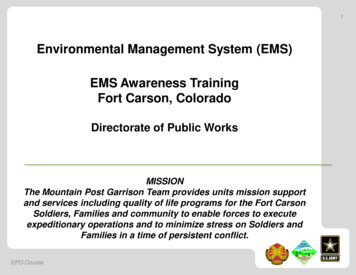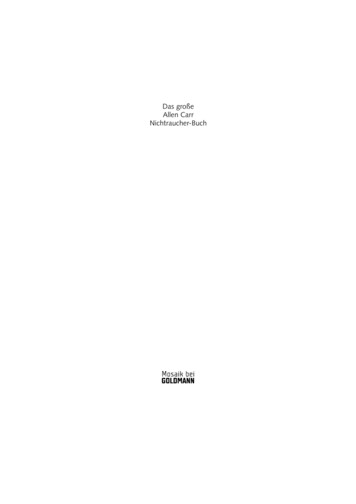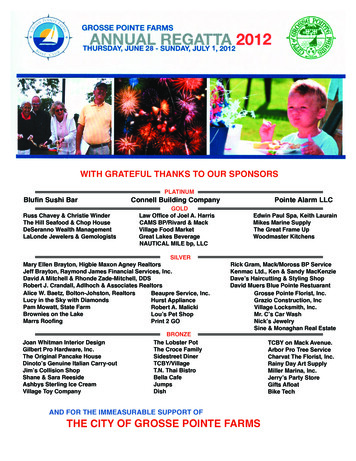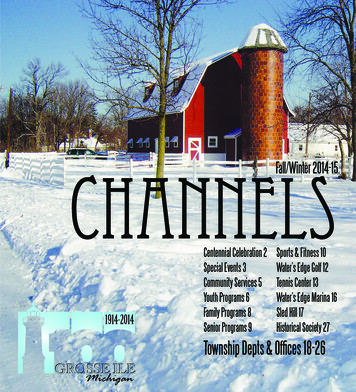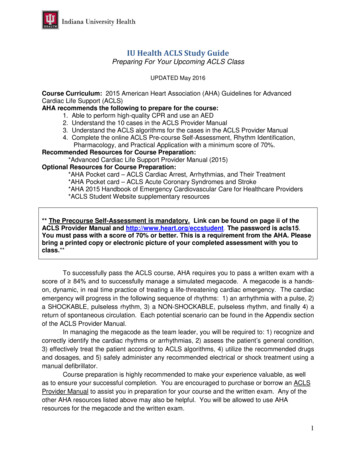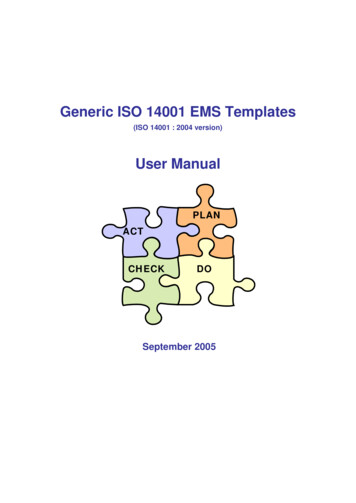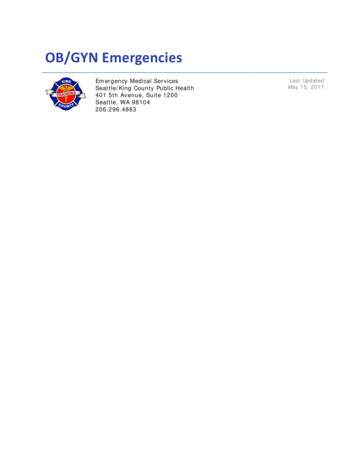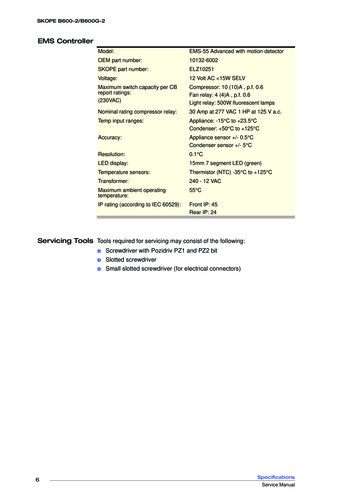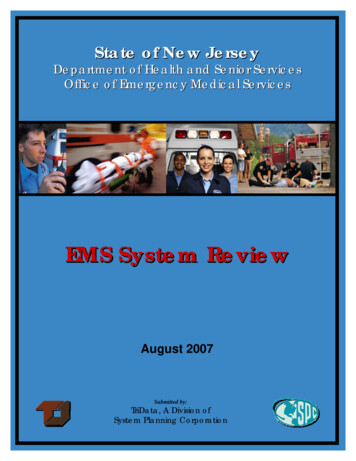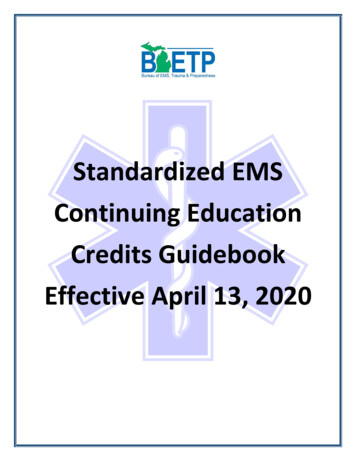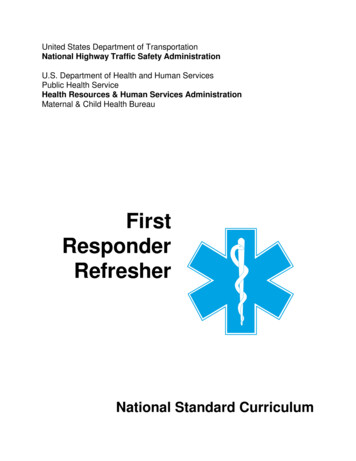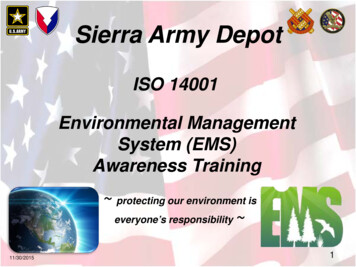
Transcription
The EmS GuideEMERGENCY RESPONSE PROCEDURES FOR SHIPSCARRYING DANGEROUS GOODSForeword . 3Contents . 4Preamble . 5How to use this Guide . 6The EmS-Guide Index . 7Fire . 24General guidelines for FIRE . 35Emergency Schedules for FIRE . 36F-A. 37F-B . 38F-C . 39F-D . 40F-E . 41F-F . 42F-G . 44F-H . 45F-I . 46F-J. 48Spillage . 50General guidelines for SPILLAGE . 60Emergency Schedules for SPILLAGE . 61S-A. 62S-B . 63S-C . 65S-D . 66S-E . 67S-F . 68S-G . 69S-H . 70S-I . 71
S-J. 72S-K . 73S-L . 74S-M . 75S-N . 76S-O . 77S-P . 78S-Q . 79S-R . 80S-S . 81S-T . 83S-U . 84S-V. 86S-W . 87S-X . 88S-Y . 89S-Z . 90
ForewordThis EmS Guide contains guidance on Emergency Response Procedures for Ships CarryingDangerous Goods including the Emergency Schedules (EmS) to be followed in case of incidentsinvolving dangerous substances, materials or articles, or harmful substances (marinepollutants), regulated under the International Maritime Dangerous Goods Code (IMDG Code).This edition takes into account the amendments to the IMDG Code (2014 Edition). The EmSGuide will be further amended as and when necessary to reflect amendments made to theIMDG Code.
ContentsForewordPreambleHow to use this GuideFIREIntroduction to the Emergency Schedules for FIREGeneral guidelines for FIREEmergency Schedules for FIRESPILLAGEIntroduction to the Emergency Schedules for SPILLAGEGeneral guidelines for SPILLAGEEmergency Schedules for SPILLAGEEmS-Guide Index
PreambleThe purpose of this Guide is to provide guidance for dealing with fires and spillages (leakages)on board ships involving the dangerous goods listed in the International Maritime DangerousGoods Code (IMDG Code).In accordance with the International Safety Management (ISM) Code, all ships, and thecompanies responsible for their operation, are required to maintain a Safety ManagementSystem (SMS). Within the SMS, procedures for responding to potential shipboard emergenciesare required. This Guide is intended to assist shipowners, ship operators and other partiesconcerned with developing such emergency response procedures, which should be integratedinto the ship's contingency plan.In November 1997, the IMO Assembly adopted resolution A.852(20) on Guidelines for a structure ofan integrated system of contingency planning for shipboard emergencies, which were further revisedby resolution A.1072(28) in December 2013. This Guide should be integrated into Module IV onResponse actions, as contained in paragraph 3.2.4.6 of the latter resolution, for cargo-related incidents.In the event of a fire or spillage incident, initial actions should be carried out in accordance withthe shipboard emergency plan. Where dangerous goods are involved, the responses in theemergency plan should be based on this Guide for specific dangerous goods having regard to,inter alia, the type of ship, the quantity and type of packaging of the dangerous goods andwhether the goods are stowed on or under deck.
How to use this Guide1The guidance contained in this Guide is intended for fire and/or spillage (leakage) emergencieson board a ship involving packaged dangerous goods transported in accordance with theprovisions of the IMDG Code. The Guide should not be used for emergencies involving bulkcargoes or any other fire and/or spillage on board a ship which does not involve packageddangerous goods as cargo.2This guidance is for shipboard use where master and crew have to respond to a fire or aspillage without external assistance. The recommendations are based on the fire safetyprovisions contained in chapter II-2 of the 1974 Safety of Life at Sea Convention (SOLAS), asamended, and the provisions of the IMDG Code. The guidance should be integrated into thecontingency plan for shipboard emergencies, which should be specific to the individual shipand should take into account the equipment on board.3There are International and national requirements for ships to contact or report to the nearestcoastal State when an incident takes place involving the loss or likely loss of packageddangerous goods (see Reporting, Procedures). Contacting shore-based experts at an early stageirrespective of how insignificant the incident may seem to be is recommended. However, itshould be noted that shore-based personnel or rescue/coastguard experts may use differenttechniques to fight a fire or to deal with spillage on board a ship.4In this Guide, there is separate advice for fire and spillage emergencies which should beconsulted accordingly.5This Guide should be used as follows:.1for fire and spillage, read and incorporate into the ship's training regime theINTRODUCTIONS to the emergency schedules, before any emergency occurs;.2in the event of an emergency involving packaged dangerous goods, consult theGENERAL GUIDELINES as a first step; and.3obtain detailed advice for the specific cargo(es) involved by reading the relevantEMERGENCY SCHEDULE(S) (EmS) for the cargo(es).
The EmS-Guide IndexEach current UN substance identification number (UN Number) is allocated to EmS-Fire andSpillage Schedules as shown below. Underlined EmS codes (special cases) indicate asubstance, material or article for which additional advice is given in the emergency responseprocedures.
UN 60070007200730074007500760077EmS F-BF-BF-BF-BF-BF-BF-BF-BF-BF-BF-BF-BEmS XS-XS-XS-XS-XS-XS-XS-YS-XS-YS-YS-ZS-ZUN 00151015301540155015901600161EmS F-BF-BF-BF-BF-BF-BF-BF-BF-BF-BF-BF-BEmS XS-ZS-YS-YS-YS-YS-YS-YS-YS-YS-YS-YS-YUN 60234023502360237023802400241EmS F-BF-BF-BF-BF-BF-BF-BF-BF-BF-BF-BF-BEmS YS-XS-YS-ZS-XS-YS-ZS-YS-YS-XS-XS-XS-X
UN mS BEmS S-XS-XS-XS-XS-XS-XS-XS-XS-XS-YS-XS-XS-XS-XS-XS-XS
Goods Code (IMDG Code). In accordance with the International Safety Management (ISM) Code, all ships, and the companies responsible for their operation, are required to maintain a Safety Management System (SMS). Within the SMS, procedures for responding to potential shipboard emergencies are required. This Guide is intended to assist shipowners, ship operators and other parties
